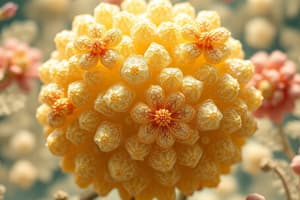Podcast
Questions and Answers
What property distinguishes cellulose from starch and glycogen?
What property distinguishes cellulose from starch and glycogen?
- It is composed of different monosaccharides.
- It provides significant calories for humans.
- It is a heteropolysaccharide.
- It does not twist into compact spirals due to bond orientation. (correct)
What is the primary role of enzymes in chemical reactions?
What is the primary role of enzymes in chemical reactions?
- To slow down reactions
- To increase temperature
- To alter the products
- To speed up reactions (correct)
Cellulose can be digested and provides calories to humans.
Cellulose can be digested and provides calories to humans.
False (B)
What are the primary components of cellulose?
What are the primary components of cellulose?
There are 25 types of amino acids that make up proteins.
There are 25 types of amino acids that make up proteins.
What are the building blocks of proteins?
What are the building blocks of proteins?
In cellulose, the orientation of the bond prevents the chains from _____ into compact spirals.
In cellulose, the orientation of the bond prevents the chains from _____ into compact spirals.
An amino acid has a central carbon called the _____ carbon.
An amino acid has a central carbon called the _____ carbon.
Match the following types of polysaccharides with their characteristics:
Match the following types of polysaccharides with their characteristics:
Match the type of amino acid side chain with its property:
Match the type of amino acid side chain with its property:
Which animals can digest cellulose due to specific microorganisms in their guts?
Which animals can digest cellulose due to specific microorganisms in their guts?
Heteropolysaccharides consist of only one type of monosaccharide.
Heteropolysaccharides consist of only one type of monosaccharide.
What type of bond links amino acids together in proteins?
What type of bond links amino acids together in proteins?
A dipeptide is formed from three amino acids.
A dipeptide is formed from three amino acids.
What is a major benefit of cellulose in the human diet?
What is a major benefit of cellulose in the human diet?
What defines the properties of a protein?
What defines the properties of a protein?
The long chains of glucose units in starch and glycogen are connected by _____ bonds.
The long chains of glucose units in starch and glycogen are connected by _____ bonds.
Each protein molecule has an amino terminus and a _____ terminus.
Each protein molecule has an amino terminus and a _____ terminus.
What type of polysaccharides can be classified into glycosaminoglycans, glycoproteins, and glycolipids?
What type of polysaccharides can be classified into glycosaminoglycans, glycoproteins, and glycolipids?
What type of reaction occurs when peptide bonds are formed?
What type of reaction occurs when peptide bonds are formed?
Which secondary structure is characterized by a spiral conformation stabilized by hydrogen bonds?
Which secondary structure is characterized by a spiral conformation stabilized by hydrogen bonds?
Prions are a type of DNA that can cause disease.
Prions are a type of DNA that can cause disease.
Name one disease caused by prions in humans.
Name one disease caused by prions in humans.
The secondary structure known as the ______ involves two or more polypeptide chains lying side by side and cross-linked by hydrogen bonds.
The secondary structure known as the ______ involves two or more polypeptide chains lying side by side and cross-linked by hydrogen bonds.
Match the following diseases with their associated prion:
Match the following diseases with their associated prion:
Which disaccharide is primarily found in milk?
Which disaccharide is primarily found in milk?
Maltose consists of two molecules of fructose linked together.
Maltose consists of two molecules of fructose linked together.
What is the characteristic linkage in maltose?
What is the characteristic linkage in maltose?
Sucrose is made of ________ and ________.
Sucrose is made of ________ and ________.
Match the following disaccharides with their descriptions:
Match the following disaccharides with their descriptions:
What is the impact of lactose intolerance?
What is the impact of lactose intolerance?
The digestion of disaccharides occurs mainly in the stomach.
The digestion of disaccharides occurs mainly in the stomach.
What is the common treatment for lactose intolerance?
What is the common treatment for lactose intolerance?
What is a characteristic of saturated fatty acids?
What is a characteristic of saturated fatty acids?
Oils are solid at room temperature.
Oils are solid at room temperature.
What are the two basic units that fats and oils contain?
What are the two basic units that fats and oils contain?
___ fatty acids are characterized by having one or more carbon-carbon double bonds.
___ fatty acids are characterized by having one or more carbon-carbon double bonds.
Match the following types of fatty acids with their descriptions:
Match the following types of fatty acids with their descriptions:
Which of the following fatty acids is considered monounsaturated?
Which of the following fatty acids is considered monounsaturated?
Cis configuration is the common orientation for biological unsaturated fatty acids.
Cis configuration is the common orientation for biological unsaturated fatty acids.
Name one fatty acid that is classified as a short-chain fatty acid.
Name one fatty acid that is classified as a short-chain fatty acid.
Trans unsaturated fatty acids can be produced synthetically by partial ________ of fats and oils.
Trans unsaturated fatty acids can be produced synthetically by partial ________ of fats and oils.
What health effects are associated with trans unsaturated fatty acids?
What health effects are associated with trans unsaturated fatty acids?
Flashcards are hidden until you start studying
Study Notes
Disaccharides
- Composed of two monosaccharide units, disaccharides are glycosides prevalent in nature, providing significant dietary energy.
- Key examples include lactose, maltose, and sucrose, each playing distinct roles in nutrition.
- Sucrose: Common table sugar, made of α-glucose and β-fructose, produced in plant leaves, serves as energy transport for plants.
- Maltose: Known as malt sugar, formed by starch hydrolysis, contains α(1,4) glycosidic linkage between two glucose molecules.
- Lactose: Milk sugar, consists of galactose and glucose linked via a β-glycosidic bond, fundamental for energy in milk.
Digestion and Absorption
- Disaccharide digestion is facilitated by enzymes from the small intestine; enzyme deficiency can lead to digestive issues.
- Carbohydrate absorption mainly occurs in the large intestine, causing osmotic pressure that draws water, potentially leading to diarrhea.
- Gut bacteria digest disaccharides through fermentation, producing gas that may cause bloating and cramps.
- Lactose intolerance: Common deficiency in adults, inherited as autosomal recessive, varying dramatically in prevalence across populations (3% in Danes vs. 97% in Thais). Managed by dietary elimination or lactase enzyme treatment.
Polysaccharides
- Composed of numerous monosaccharide units linked by glycosidic bonds, resulting in compact structures important for living organisms.
- Cellulose: Structural component of plant cells, providing strength and rigidity, differing from starch in molecular orientation and bonding, leading to its fibrous quality.
- Distinct physical properties result from the orientation of glycosidic bonds; starch and glycogen form twisted chains while cellulose remains straight.
Homopolysaccharides vs. Heteropolysaccharides
- Homopolysaccharides: Enzymes can break down starch and glycogen, but cellulose is resistant, except in certain organisms (e.g., termites).
- Heteropolysaccharides: High molecular weight polymers composed of different monosaccharides, categorized into glycosaminoglycans, glycoproteins, and glycolipids.
Fatty Acids
- Long chain carboxylic acids, saturated fatty acids feature unbranched linear chains with only single carbon-carbon bonds, maximizing hydrogen atoms.
- Unsaturated fatty acids contain one or more carbon-carbon double bonds, classified as monounsaturated (one double bond) or polyunsaturated (multiple double bonds).
- Spatial configurations of fatty acids can be cis or trans; the cis configuration is predominant in biological systems, while trans unsaturated fats may have negative health effects.
Proteins
- Proteins are polymers of amino acids linked by peptide bonds, with 20 amino acids forming vast protein diversity.
- Amino acids are characterized by a central carbon with an amino group, carboxyl group, hydrogen atom, and variable R group, influencing protein behavior.
- Peptide bonds form through condensation reactions, leading to chains with distinct amino and carboxyl termini.
- Secondary structures: α-helix (spiral formation due to hydrogen bonding) and β-pleated sheet (folds formed by hydrogen bonding between adjacent chains).
Prions
- Prions are infectious, misfolded proteins causing transmissible spongiform encephalopathies in mammals, including BSE in cattle and CJD in humans.
- All prion diseases lead to brain structure abnormalities, are untreatable, and fatal, involving amyloid folds of beta sheets instead of typical alpha helices.
Studying That Suits You
Use AI to generate personalized quizzes and flashcards to suit your learning preferences.




